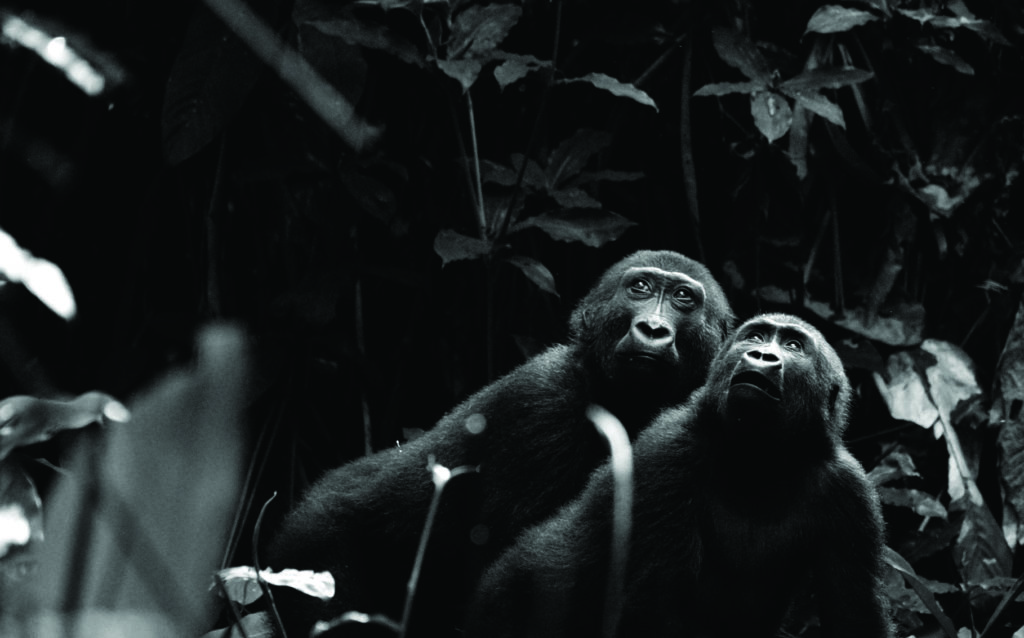It was just after the crack of dawn that my tracker and I were hacking our way through the thick undergrowth of the Odzala-Kokoua National Park in the Republic of Congo (also Congo-Brazzaville). Soon we could sense the presence of a large group of gorillas. They were foraging for roots, shoots and termites while a few were high up in the trees in search of fruits. Out of nowhere, a pair of brown eyes was suddenly gazing at us from behind the undergrowth. It was a young juvenile male, also very curious. He stared, blinked and then emerged from his seclusion, almost as though he wanted to greet us in his abode.
This moment could not have happened but for over 17 years of hard work by researchers who have helped habituate gorillas to human presence. This difficult process has been accomplished by the sheer skill of the famous BaAka (pygmy) trackers. Unlike with the mountain gorillas, the habituation process of western lowland gorillas has proven difficult because of several factors: limited visibility in the lowland forests, difficulties following gorilla tracks through the dense forest and across the long distances that they travel.
The Odzala park in Congo’s remote north-west is one of Africa’s oldest. It is 13,600 square kilometers of pristine rainforest and an integral part of both the Congo Basin and the TRIDOM Transfrontier Park overlapping Gabon, Congo and Cameroon.

Gorillas are still being hunted for their bush meat and the young sold as pets; five percent of the species is killed each year.
Covered in forests, rivers, marshes and swamps, the park receives 1,500 millimeter of rain annually. The TRIDOM is the first three-country transboundary area to become a World Heritage Site and is one of the largest blocks of pristine tropical lowland forest in the world.
Loading...
As the juvenile gorilla approached me, two other members of the group, a young female and another male, peeked through the undergrowth. The three of them were fast approaching me. While my heart was pounding with excitement, I was reminded by the tracker and forest companion Zephron that we had to maintain a seven meter distance from the animals, lest we transmit human diseases. So I had to backtrack with a heavy heart while still covering my face with a surgical mask.
My tracker understood their movements and soon positioned me in a different location. His tracking experience came to play as the huge silverback male emerged right in front of me. Known as Neptuno by the researchers, he was 35 years old, handsome, big and 380lbs to boot. He managed his group of 16 gorillas by leading, protecting and showing them prime feeding grounds. Neptuno was keeping a check on me while ensuring his group’s safety. Soon, the other 15 members filed past me. Some stopped to look, others rushed while a few sat down to observe me. Neptuno was with the young and either led the group or stopped to ensure their safety. He was known to charge human beings when threatened.
Odzala Camps was launched in 2013, boasting the highest density of gorillas in Africa including seven habituated western lowland gorilla families (about 105 gorillas). Visitors encounter 11 species of diurnal primates including chimpanzee, De Brazza’s monkey, putty-nosed monkey, grey-cheeked mangabey, crowned monkey, colobus monkey and moustached monkey. The area includes birdlife and herds of forest elephant and dwarf buffalo.

I am one of less than 750 visitors to have experienced this park. Access was impossible prior to 2013. It took a long time for Spanish primatologist Magda Bermejo to win the trust of the Ndzehi people as they had seen western lowland gorillas in the rainforest being poached, hunted for trophies, or shipped off to zoos. Eventually, when she earned their respect, the Ndzehi packed up their whole village and moved with Bermejo to Lossi, home to the largest population of gorillas in the Congo, to help her with her research. Their intimate knowledge of the rainforest and gorilla-tracking skills proved invaluable to Bermejo’s work.
A recent census of the gorilla populations in equatorial Africa was thought to be 100,000. In 2004, there was an Ebola outbreak in Odzala wiping out 90% of the resident population of 10,000. Because of these outbreaks, the International Union for Conservation of Nature updated the status of western lowland gorillas from “endangered” to “critically endangered”.
The gorillas are still being hunted for their bush meat and the young sold as pets; five percent of the species is killed each year. Commercial poaching of chimpanzees, forest elephants, and western gorillas results from increased amount of commercial logging and infrastructure. The Wildlife Conservation Society is working in the Congo and surrounding countries to limit the bush meat trade by enforcing laws and also helping the local people find new sources of protein.
Loading...
